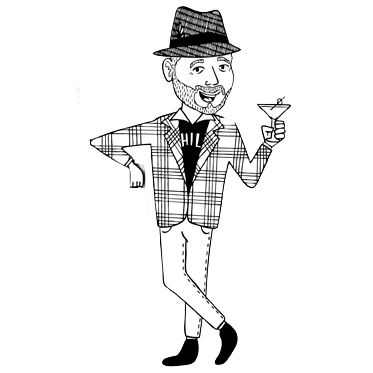 One of the classiest hotels in Philadelphia at the turn of the 20th century was the brand new Hotel Walton. For a little background, we go to one of our favorite blogs, the one at Phillyhistory.org: The Hotel Walton, located on the southeast corner of Broad Street and Locust Street, opened in February 1896 and incorporated the Hotel Metropole, an earlier establishment on the same site. Upon its completion, the hotel featured a ladies’ restaurant, a gentlemen’s café, several parlors, a banquet hall, and 400 guest rooms (200 of which had separate baths). The hotel would eventually be known as the John Bartram Hotel before being demolished in the 1960s.
One of the classiest hotels in Philadelphia at the turn of the 20th century was the brand new Hotel Walton. For a little background, we go to one of our favorite blogs, the one at Phillyhistory.org: The Hotel Walton, located on the southeast corner of Broad Street and Locust Street, opened in February 1896 and incorporated the Hotel Metropole, an earlier establishment on the same site. Upon its completion, the hotel featured a ladies’ restaurant, a gentlemen’s café, several parlors, a banquet hall, and 400 guest rooms (200 of which had separate baths). The hotel would eventually be known as the John Bartram Hotel before being demolished in the 1960s.
I stumbled onto a treasure trove of info about the Hotel here. Clumsy to maneuver, it is a paper written by the National Park Service on a typewriter many years ago and later uploaded onto the Web. Major thanks to whoever scanned it in.
The architect of the Hotel Walton was Angus Wade, who also designed the Hotel Hanover, the Bingham Hotel, and the Hotel Rittenhouse, all spectacular structures that no longer stand (The Hotel Rittenhouse is not the Rittenhouse Hotel, but rather a hotel that was at 21st and Chestnut.) Poor Angus. He did perhaps also design the still standing Carriage House, now a B&B near Penn on 46th Street, though there are no good photos of it on their website.
 Am I rambling on about a guy named Angus? Where was I? Ah yes, the Hotel Walton. There was a hotel called the Hotel Metropole at that address but the Hotel Walton incorporated it as part of the much larger Hotel Walton. It opened in February of 1896, and the paper includes the coolest thing I’ve found yet while researching these hotels: a Public Ledger article about the opening written on February 13, 1896. Here is the opening to the story, and a full description of the hotel is offered after the jump:
Am I rambling on about a guy named Angus? Where was I? Ah yes, the Hotel Walton. There was a hotel called the Hotel Metropole at that address but the Hotel Walton incorporated it as part of the much larger Hotel Walton. It opened in February of 1896, and the paper includes the coolest thing I’ve found yet while researching these hotels: a Public Ledger article about the opening written on February 13, 1896. Here is the opening to the story, and a full description of the hotel is offered after the jump:
“Thousands of People thronged the new Hotel Walton from roof to basement last evening, on the occasion of its formal opening, when a scene of brilliancy was presented which has seldom been equalled in this city. The event served a two-fold purpose, as it not only showed off the magnificence of this new hostelry, but gave an opportunity for the gentler sex to display their new midwinter gowns.”
How did it get the name Walton? That info comes to us in the next article in the typewritten paper, which is actually from a year earlier:
The name Walton is in honor of a bright little son of Robert Goelet, who owns the property, Master Robert Walton Goelet, and the young lad is very proud of the distinction that has been shown him.
Robert Goulet was the original owner?!! Oh wait, nevermind, it’s Goelet, not Goulet. My bad. Anyways, I bet his son was an insuffereable, obnoxious punk about having that Hotel named after him. When he was in his early 20s, I bet he constantly bragged to women that he was the namesake of the Hotel Walton, but I bet the women blew him off anyway, because he was so annoying about it. I bet our boy Angus couldn’t stand the little punk, but kept up appearances when he came around, just so Robert Goulet Goelet wouldn’t get mad.
In 1946, the Hotel Walton went into bankruptcy. I suspect the spoiled rotten little brat who the hotel was named after spent all of the money on fast cars and easy women, but I am completely making that up and not basing it on any “facts” or “research”. Nonetheless, it went into bankruptcy in 1946 and reopened as the John Bartram Hotel in 1946. It was torn down in 1966. Ok, for a real treat, after the jump I’ll tell you where to find a bunch of pictures of the Hotel, what the postcards said, and post the entire 1896 description of the Hotel when it opened.
Continue reading “Old Philly Postcards: The Hotel Walton” →
 In case you missed it last week, I bought some 100 year old postcards of old Philadelphia landmarks and decided to do research on the buildings on the front of them. There is some very cool stuff here.
In case you missed it last week, I bought some 100 year old postcards of old Philadelphia landmarks and decided to do research on the buildings on the front of them. There is some very cool stuff here. 
















